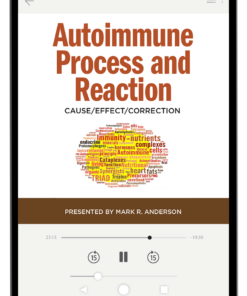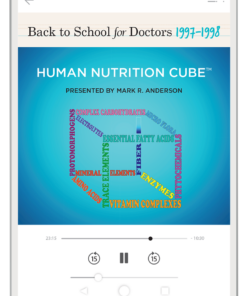In every language, the first words spoken by a woman after delivery are, “Is my baby healthy?” The first words spoken by a woman upon learning that she is pregnant should be, “Am I well nourished?”
Evidence of human birth defects dating back over three thousand years is reported in archaeological literature. Excavated ruins of ancient Babylon revealed detailed reports of infant defects.1 Achondroplastic dwarfs (failure to develop healthy cartilage at the ends of long bones, resulting in a form of congenital dwarfism) have been unearthed in ancient Egyptian tombs. Pictures drawn on ancient Peruvian pottery depict cleft lips and palates and missing limbs on babies. Aboriginal cave drawings in Australia depict gruesome deformities of infants.
The term “birth defect” refers only to structural or physiological abnormalities that develop at or before birth. However, defects in the developing fetus are most often revealed later in life. Evidence shows they often are caused by malnutrition in fetal development at a critical time when nutrients are needed to form organs. Half of all infant deaths in the U.S. are attributed to birth defects.2
Nutrition and Physical Degeneration, published in 1939 by Dr. Weston A. Price, is an enduring classic with a message that puts the people of Earth on notice: Eat right or destroy your progeny. During the 1920s and 1930s, Dr. and Mrs. Price traveled the globe to all habitable continents, photographing and recording the insidious effects of the modern diet on newly exposed indigenous people, their offspring, and their culture. Dr. Price, a superb field photographer, made a stunning visual record of the physical characteristics of native populations living on traditional diets and the subsequent altered features of their children as these family units came in contact with and incorporated modern, adulterated foods.
Regardless of the setting—a naval base installation in the tropical South Pacific; a new trading post in the arctic; a road built to connect previously remote alpine valleys; a coastal city encroaching into an arid expanse of isolated Australian “outback”—the result of the contact and assimilation was always the same: The indigenous people were seduced into eating the “foods of commerce” (as Dr. Price referred to them). Within a single generation, their freedom from chronic disease was lost, and physical degeneration set in. The next generation paid a high price, and it got worse with each subsequent generation: tooth decay, tuberculosis, physical deformities, arthritis, diabetes, diseases of the GI tract, infertility, cancer, and mental illness. Diseases often lacking names or descriptions in the local language soon became as common as they were in the modern “civilized” population.
Dr. Price’s first profound observation was the speed at which the teratogenic effects of processed, canned, preserved, adulterated, sweetened, and refined foods could be recorded in the local population and gene pool. The indigenous people held up a mirror to the advancing modern cultures of the world, and Dr. Price captured the reflection on film. The mirror reflected an image that said, “When we eat as poorly as you, we lose our genetic strength within a single generation and are soon plagued by the diseases you know so well.” If a picture says a thousand words, the thousands of photographs taken by Dr. Price and the stories behind them are revealing far beyond words. The fact that Nutrition and Physical Degeneration is not part of the corpus curriculum of every school in the healing arts is an indictment against their authority to teach the tenets of health.
Studies in Deficiency Disease, published in 1921 by Major-General Sir William McCarrison, preceded Price’s work. It came to similar conclusions based on McCarrison’s studies with the famed Hunza people in the Himalayan Mountains near what is today northern Pakistan. McCarrison was a British physician assigned to the army, serving in India during the first two decades of the 20th century. He was fascinated with the robust health and extreme longevity of the Hunza, where the age of 100 was common. Living at about 9,000 feet in a glacial valley, vigorously working to the end of their lives, their ubiquitous physical well-being inspired McCarrison. He studied their diets and noted that as these isolated people came into commercial contact with the British army and consumed their foods, they soon forfeited their legendary health.
McCarrison, who became the mentor of the famed naturalist writer and publishing magnate J.I. Rodale, set up the Nutrition Research Laboratories at Coonoor in India and conducted careful food experiments with animals. He recorded the same results that Price would later observe. The first crucial effect of refined and adulterated nutrition was the destruction of the endocrine system, upon whose biochemical messengers the entire body is dependent. In his book, he noted that the British diet, which was also common in the U.S. and Europe, was custom-made to damage the endocrine system in humans and animals. He noted that destruction first occurred in the adrenal glands and then cascaded to the thyroid and pancreas and finally to the central nervous system. In a speech to the British Medical Association in 1936, reflecting on his forty years of research (for which he received a knighthood), he said3:
“Contacts of nutrition with obstetrics and gynaecology are many. It will suffice to mention some of them: the impediments which the effects of rickets and osteomalacia may present to parturition; the relations of food, in particular of fats, mineral elements, and vitamins, to fertility, pregnancy, and lactation; the role of linoleic acid (sometimes called vitamin F) in favouring fertility; the probably effect of fat in facilitating the transference of vitamin A through the placenta to the fetus; the need for an abundant supply of vitamins A, B, and C and of calcium, phosphorus, magnesium, and iron to pregnant and lactating women, and their need for adequate supplies of vitamins D and E and of iodine; the role of vitamin E in preventing habitual abortion; the effects of vitamin A deficiency on the reproductive tract—vaginal cornification, prolonged gestation, difficult parturition, uterine bleeding, variations in size of the placenta, tissue necrosis of the uterine wall—effects which in their turn may favour endogenous or exogenous infection…All these observations indicated the necessity for the proper feeding of prospective mothers, and of pregnant and nursing women: a necessity as much in the interests of the child as of the mother.”
The great nutritional pioneer Dr. Royal Lee addressed the biological conveyance of acquired behavior (habits of the progenitor) to one’s progeny in a speech before the American Academy of Applied Nutrition on February 23, 1950:
“The exact mechanism by which an acquired trait can become hereditary is in fact fairly well established. It seems that each specialized cell of the body produces continually, and discharges into the bloodstream, what might be called ‘blueprints’ that guide or determine the nature of regenerating new cells that can assimilate these specialized organic substances, which act as blueprints. Biologists call these factors determinants, and there is clear evidence that the germ cells of the sex glands obtain these determinants from the bloodstream and pack them into chromosomes, where they can in turn accomplish their function of determining the characteristics of the offspring as they unfold during the development of the embryonic tissues. It is now easy to see that if both parents are lacking in the specialized cells of the islets of Langerhans, the offspring of such parents is bound to have either a weakened group of the these islets or none at all, depending on the severity of the parents’ disability. It is of further interest to find that these determinants owe their specific nature to the pattern of trace minerals of which they are composed.
“Therefore, trace mineral deficiency, it is evident, can act also to impair hereditary transmission. And as these trace minerals in the determinants are combined organically to protein linkages, it is evident how the nature of these minerals in our foods can be of vital importance. Compost gardening, in building up the organic mineral levels of the soil, is here justified, and its results explained.”4
Dr. Lee’s statement should serve to explain why juvenile diabetes is increasing so rapidly in the Western world and wherever else high-carbohydrate diets, loaded with sugar and glucose, have been adopted.
Furthermore, Lee’s conclusion about trace minerals was supported by McCarrison’s observation that the glacier-fed soil of the Hunza valley was extraordinarily mineralized by the slow grinding of the glacier and springtime inundations. Even their fresh river water was cloudy with minerals. He never saw a single rotted tooth or osteoporosis among the Hunza, even in those over 100 years old (unless they abandoned their ancestral diet).
It appears that isolation from Western civilization and its foods of commerce, combined with obedience to time-honored dietary traditions and folklore in the local population, afforded a diet that protected health and lengthened lifespan. Birth defects were nonexistent, and the strongest genetic profiles transferred easily to each generation. The dietary traditions found in the knowledge and folklore of these isolated cultures looked nothing like our modern USDA Food Pyramid, unless, perhaps, if it is turned upside-down and all the foodstuffs are consumed in their unrefined state.
Vitamin deficiencies known to cause birth defects in animals include [those of] thiamine, riboflavin, niacin, pantothenic acid, folate, and vitamins A, B6, B12, C, D, E, and K. In animal studies, shortages of these nutrients cause cleft palate, hydrocephalus (water on the brain), conjoined twins, and kidney, limb, eye, and brain malformations.
Post-Soviet Russia offers a shocking view of the combined effects of pollution and starvation on human progeny. The head of Russia’s environmental commission states that ten percent of Russian children are born with deformities (increasing by two percent annually). One-fifth of these is attributed to environmental toxins.5 He cites studies that point to the widespread use of foods contaminated with agricultural chemicals along with grinding poverty that keeps pregnant women from obtaining little more than survival levels of protein, minerals, and vitamins. The Russian diet rarely includes meat, fish, eggs, or dairy. Neonatal nutrition for many Russian women is primarily starchy food, providing carbohydrate calories and little more.6 UNICEF reports that only 9 percent of Russian babies are considered completely healthy. It is of little surprise that a staggering 60 percent of Russian infants show signs of rickets.7
Long ago, nutritional pioneers such as McCarrison, Price, and Lee accurately predicted this kind of genetic destruction, acquired through dietary patterns, which passes to the chromosome of the next generation. Russia stands as a glaring example of their warning.
Let us now consider what is known about the consequence of carrying a baby while starved of the proper nutrients.
Selected Nutrients Associated with Types of Birth Defects in Humans
| Nutrient | Consequences of Deficiency to the Baby |
| Vitamin B | Clubfoot, cleft lip and palate |
| Folic Acid | Neural tube defects (incomplete development of the brain or spinal cord): spina bifida, hydrocephalus, and numerous nervous system and brain deformities.8 Orofacial defects from low folic acid and related B vitamins are noted to develop in the very early stages of pregnancy before a woman even is aware that she is pregnant.9 |
| Riboflavin | Failure to grow, thrive, and develop. |
| Thiamine | Heart defects affecting rhythm and heart size. |
| Vitamin A | The eye needs more vitamin A than any other organ during its embryonic development.10 After several successive generations, test animals fed vitamin A-deficient diets are born without eyes.
It is noteworthy here to examine the outcome of a large-scale Boston Medical University study examining the effect of vitamin A supplementation during pregnancy on the need for eyeglasses in children.11 The would-be long-term study of 22,748 women was truncated due to unexpected and alarming results. As the researchers examined the incoming data, it became clear that the supplemental vitamin A test group was experiencing an alarming rate of birth defects. At 10,000 IU per day of synthetic vitamin A, the rate of birth defects was 240% higher than the expected norm. At 20,000 IU per day, the rate soared to almost 400% higher than normal. What was significant about this study was that women whose diets contained natural food sources of vitamin A showed no increase in birth defects, even at levels in excess of the synthetic supplements. Thus, naturally occurring vitamin A tends not to approach the teratogenic levels found in synthetic vitamin A. Based on the limited results of this study, toxic levels of synthetic vitamin A appear to cause malformed heart and heart valves, abnormal brain and nervous system development (including hydrocephalus), and cleft lip and palate. It is interesting to note that isoretinoin (13-cis-retinoic acid), a drug prescribed for treating sever cystic acne, is a synthetic chemical with vitamin A activity that causes a characteristic set of birth defects in fetuses: malformed or absent external ears or auditory canals and conotruncal heart defects.12 |
| Vitamin K | Chlorophyll, in its natural, fat-soluble state, is the “blood” of plants. Vitamin K is a natural constituent of fat-soluble chlorophyll and has profound effects on the developing fetus. This vitamin is essential to the formation of prothrombin in the liver, the precursor of thrombin, which is the blood-clotting factor of the blood. Fresh, raw, green leafy vegetables provide vitamin K to the mother and fetus.
Deficiencies of K during pregnancy may lead to subdural hemorrhage and death.13 Birth trauma increases this risk. Additionally, deformities associated with prenatal vitamin K deficiency include shortened fingers, cupped ears, flat nasal bridges, and underdevelopment of the nose, mouth, and mid-face.14,15 Anticonvulsive drugs taken during pregnancy block vitamin K activity and thus are linked to these birth defects. |
| Iron | According to the World Health Organization (WHO), iron-deficiency anemia is the most common nutritional deficiency in the world. WHO estimates for iron deficiency range as 80% of the world population (5 billion people). WHO states that at least one-third of the world is currently anemic.
The fetus must store in the liver a six-month supply of iron (the key component of the oxygen-carrying hemoglobin) for post-partum life. The infant GI tract is too immature to absorb large iron-containing molecules during this time. Thus the pregnant mother must have enough of this mineral to allow sufficient storage in the fetus. Maternal hemorrhages threaten iron-deficient pregnancies. Iron-deficient babies are often smaller and shorter.16 Recent studies have positively associated brain function with iron levels in children. Iron-deficient students were 200% more likely to score below average on national math tests.17 Even though iron-deficient children often had no signs of clinical anemia, they still demonstrated lower scores. Iodine deficiency during pregnancy can result in congenital myxedema (cretinism).18 This defect is characterized in childhood by dwarfed stature, mental retardation, dystrophy of the bones, and a low basal metabolism. |
| Iodine | Mild iodine deficiency has been reported to reduce intelligent quotients by 10–15% and cause increased rates of stillbirths, perinatal mortality, and infant mortality.19
Thyroxin, an important endocrine hormone, is 65% iodine by weight.20 |
| Magnesium | When magnesium was given as a supplement to pregnant women to treat high blood pressure and premature labor, a government study found that this trace mineral sharply reduced the risk of cerebral palsy and retardation in women’s babies.21 Very low-birth-weight babies whose mothers ingested magnesium supplements during pregnancy were about 90 percent less likely to develop cerebral palsy and 70 percent less likely to be retarded than infants whose mother didn’t receive supplemental magnesium. |
| Zinc | Deficiency of zinc is common where food is raised on soil deficient in this trace mineral. Lack of zinc in pregnancy has been associated with premature birth, prolonged labor, and increased risk to the fetus as well as impaired growth and development and lowered immunity in the baby.22 Toxemia and anemia have also been associated with zinc deficiency in pregnancy.23Zinc deficiency during pregnancy has been related to many congenital abnormalities of the nervous system in children, who may later develop reduced learning ability, apathy, and mental retardation.24
Zinc deficiency has been cited as teratogenic; 15 to 20 mg of zinc per day during pregnancy could potentially avert between 7 to 60% of all low-weight births. The range is wide because it is often difficult to isolate the effects of zinc deficiency from other micronutrients that are concurrently deficient.25 |
| General malnutrition caused by famine during pregnancy | Long-term research by Columbia University and University Hospital Ulrecht in the Netherlands showed a significant spike in schizophrenia during the “Dutch Hunger Winter,” a severe famine that occurred between October 1944 and May 1945. The incidence of schizophrenia was 200% higher among Dutch who were conceived, gestated, and born during the Nazi occupation and blockade late in WWII,26 during which all transport of food was banned over inland waterways to the western part of Holland, where such large cities as Amsterdam, Rotterdam, and The Hague are located. Adding to the severe rationing since early in the war, the situation was soon desperate. There was a high mortality rate during the famine and a significant increase in neural-tube birth defects in babies.Much like a tree does not show growth rings during years of drought, the layers or folds of areas in the brain apparently did not develop in the fetuses of starving pregnant women. These children were far more likely to develop schizophrenia, and this study led the researchers to suggest that half of all schizophrenia may be the result of malnutrition during pregnancy. This has great implications for the study of schizophrenia and other forms of developmental mental illness. Certain cases of schizophrenia can almost certainly be considered birth defects related to nutritional deficiency. |
By Mark Anderson. From the Historical Perspective section of Whole Food Journal, circa 2000.
End Notes
- Ballantyne, J.W. Trans. Edin. Obst., Soc XVII 99, 1892.
- Jennifer Howse, president of the March of Dimes, quoted in USA Today, April 12, 2000.
- British Medical Journal, September 26, 1936.
- Dr. Royal Lee. “Malnutrition and Heredity.” Lectures by Dr. Royal Lee, Vol. 1, p. 89. Selene River Press, Inc., 1999.
- York, Geoffrey. “Statistics on Birth Defects in Russia Are Staggering.” The Detroit News, July 30, 1995.
- Ibid.
- Ibid.
- Czeizel, A.E., et al. “Prevention of the First Occurrence of Neural-Tube Defects by Periconceptual Vitamin Supplementation.” N. Engl. J. Med., 327(26):1832–1835, 1992.
- Lancet, 346(8972):393–396, 1995.
- Dr. Royal Lee. “Malnutrition and Heredity.” Lectures by Dr. Royal Lee, Vol. 1, p. 89. Selene River Press, Inc., 1999.
- Rothman, K.J., et al. “Teratogenicity of High Vitamin A Intake.” N. Engl. J. Med. 333(21): 1369–1373, November 23, 1995.
- Oakley, Godfrey P., et al. “Vitamin A and Birth Defects—Continuing Caution Is Needed.” N. Engl. J. Med., 333(21):1414–15, November 23, 1995.
- Scope. The Upjohn Company, 1965.
- Howe, A.M., et al. “Prenatal Exposure to Phenytoin, Facial Development, and a Possible Role for Vitamin K.” Am. J. Med. Genet., 58(3):238–244, 1995.
- Boneh, A, Bar-Ziv J. Department of Pediatrics, Hadassah University Hospital, Mt. Scopus, Jerusalem, Israel. “Hereditary Deficiency of Vitamin K-dependent Coagulation Factors with Skeletal Abnormalites.” Am. J. Med. Genet., 65(3):241–3, October 28, 1996.
- American Journal of Clinical Nutrition, Vol. 66, 1997.
- Dr. June Halterman. Pediatrics, June 2001.
- Thyroid Foundation of Canada. Thyrobulletin, Vol. 19, No. 3, 1998.
- Haddow, J.E., et al. “Maternal Thyroid Deficiency During Pregnancy and Subsequent Neuropsychological Development of the Child.” N. Engl. J. Med., 341(8):549–555, 1999.
- Ibid.
- “Magnesium May Help Reduce Birth Defects.” Associated Press report, Dec. 11, 1996. Original article in Journal of the American Medical Association, Dec. 11, 1996, by Diana Schendel of CDC, Atlanta.
- Prasad, A.S. “Zinc Deficiency in Women, Infants and Children.” J. Am. Coll. Nutr., 15(2):113–120, 1996.
- Favier, A., et al. “Effects of Zinc Deficiency in Pregnancy on the Mother and the Newborn Infant.” Rev. Fr. Gynecol. Obstet., 85(1):13–27, 1990.
- Pfeiffer, C.C., et al. “Zinc, the Brain and Behaviour.” Biol. Psychiatry, 17(3):513–532, 1982.
- Cavdar, A.O., et al. “Zinc Deficiency and Anencephaly in Turkey.” Teratology 22: 141, 1980.
- Archives of General Psychiatry, 53(1): 25–31, 1996. Publication of the AMA.





